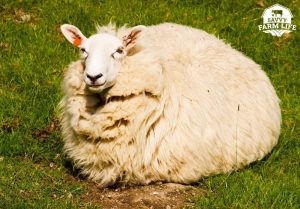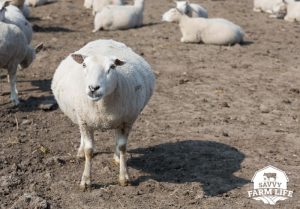
How to Keep Your Sheep From Falling Over and Getting Stuck
If you have ever seen a picture or a video of a sheep lying on its back with its legs in the air, you may chuckle at the cuteness of the sunbathing sheep. What you may not know is that a sheep in this position is in distress and unable to get up on their own. What causes sheep to get stuck in this position?
A sheep on its back likely got into that position either by getting stuck while rolling around, or by simply tipping over. Sheep are more vulnerable to getting stuck on their backs when they are heavily pregnant, when they have a full fleece, or when their fleece is wet (and heavy) from the rain. A sheep in this situation needs immediate attention, as they can suffer and die if left alone.
So I guess turtles aren’t the only animals that have this problem. If you see one of your sheep in this position, you need to help them get upright and on their feet as soon as possible. To learn more about how to prevent this from happening, read on!
Reasons A Sheep May Fall Over And Get Stuck
A sheep, like a horse or dog, may roll over to scratch an itch. After all, they don’t have appendages that can reach behind them to scratch like we humans do. If a sheep is vulnerable to getting stuck, they may roll onto their back only to realize they can’t roll back over to their side. When this happens, they are truly stuck – unable to right themselves without assistance.
A sheep may also simply tip over under the weight of a wet, heavy fleece or during the late stages of pregnancy. When this happens, they may attempt to move their body to get back up, only to roll further onto their back and become stuck. Think about the weight of a wet sponge as opposed to the weight of a dry sponge – a significant amount of water can saturate a sheep’s wool during the rainy season. This additional weight will make the sheep significantly heavier and can alter their ability to right themselves after falling down.
When Are Sheep More Prone To Falling Over?
In which circumstances are sheep more susceptible to falling over and getting stuck in this way?
Late Stage Pregnancy
A sheep’s gestation period is around 20 weeks, but 70% of fetal development occurs during the last four to six weeks of pregnancy. Taking into account that most sheep have twins or triplets, this is a significant change in weight in a very short period of time for a ewe. Just as is the case with humans, a sheep’s center of gravity can become altered during this late stage of pregnancy. A sheep’s center of gravity is at the shoulders, and pregnancy can make her feel off balance as she heads closer to lambing. She may find herself overcompensating while grazing, causing her to fall over.
When a heavily pregnant sheep tips over, the shear size of her abdomen may cause her to roll further onto her back. Once on her back she will be too heavy (and round), to roll back onto her side. Most ewes will gain between 10 and 30 pounds when pregnant – more if giving birth to multiples. Imagine having a 30-pound bowling ball on your stomach. If you are lying on your back, it will be significantly more difficult to get up in this state than it would otherwise.
Are you new to breeding sheep and don’t know how to tell whether a sheep is pregnant or not? Visit my article How To Tell If A Sheep is Pregnant: Sheep Pregnancy Guide.
Heavy Coat Of Wool
Sheep are typically sheared annually – in the late Spring or early Summer (or a month or two before lambing). During these 12 months, a sheep can have significant wool growth depending on the breed. Shepherds can get anywhere from 2 to 30 pounds of fleece off of a single sheep per year. Imagine having 20 pounds of fleece on you – this wool will be heavy and dense.
Have you ever seen a viral video of a toddler falling over in the snow with her large snow jacket on, getting stuck on her back because she can’t get back up? This is just how a sheep with a heavy fleece will get stuck on his back. 30 additional pounds of fleece is a lot to carry around – if a sheep tips over and gets stuck on his back, the extra wool will create a thick, wide barrier between his back and the ground. It can alter the shape of the sheep’s back – making it flatter instead of round, and he can easily have trouble getting back up on all fours.
Wet Wool
Now think about that full coat of wool, but instead of 20 pounds of dry wool, it weighs twice that because it is saturated from being in the rain. While sheep don’t particularly enjoy being wet, they will usually brave the rain to graze, especially if they are accustomed to the wet weather. Wet wool is a lot heavier than dry wool, and the problems a sheep will endure falling over will become exacerbated if he has a full coat of wet wool.
Want to know some of the best sheep breeds for wool? Visit my article Best Sheep For Wool: Top 8 Sheep Breeds For Wool.
What To Do If Your Sheep Is Stuck On His Back
 If you see a sheep stuck on his back, take action immediately. If this is your sheep, approach her and grab a handful of fleece (or a leg if you can’t get a good amount of fleece in your hand). Once you have a good grip, simply roll the sheep back over onto her side. Your sheep may be dazed – especially if she has been on her back for longer than a few minutes. You’ll want to make sure to keep her secured for a few minutes until she seems steady enough to get back on her feet. Once she’s on her feet, keep an eye on her. If she is still dazed, she is more likely to fall over and get stuck again. Stay in the pasture with her until she looks steady and is exhibiting normal behavior.
If you see a sheep stuck on his back, take action immediately. If this is your sheep, approach her and grab a handful of fleece (or a leg if you can’t get a good amount of fleece in your hand). Once you have a good grip, simply roll the sheep back over onto her side. Your sheep may be dazed – especially if she has been on her back for longer than a few minutes. You’ll want to make sure to keep her secured for a few minutes until she seems steady enough to get back on her feet. Once she’s on her feet, keep an eye on her. If she is still dazed, she is more likely to fall over and get stuck again. Stay in the pasture with her until she looks steady and is exhibiting normal behavior.
If you come across a sheep that is stuck and it isn’t yours, try to alert a local farmer or shepherd. It would be best to have someone familiar with the sheep to approach and right the animal – otherwise you can cause even more stress than is necessary to the sheep. Of course, if you can’t quickly find a farmer, do what you can to get the sheep back on her feet. A frightened sheep is better than a suffering sheep.
Preventing Your Sheep From Falling Over
In the case of a heavily pregnant sheep, there is little you can do to keep her from falling down. Some sheep are more susceptible to these balance problems than others, so it helps to know your sheep. Keep an extra eye on her – which you are likely doing anyway since her lambs are approaching.
If your sheep is falling over because of a heavy fleece, you might decide to shear them a little early so long as the weather is not too cold. You can also shear them and blanket them if you need to in order to keep them warm. If that’s not possible, you will want to check on your sheep more than you usually do. There is little else that can be done to prevent your sheep falling over in this condition.
In the case of wet wool, you want to make sure that you have sufficient shelter for your sheep to get out of the rain. If your sheep have adequate shelter, they may choose to spend less time grazing in the rain.
If your sheep is falling over and is overweight, the easy solution here is to get your sheep to a more manageable weight. This should be done for a variety of reasons – not only because he will be less likely to tip over, but also to avoid a host of other health problems associated with obesity.
A Stuck Sheep Is A Dead Sheep
Unfortunately, when a sheep is stuck on its back, it can be fatal unless help arrives. There are a few different dangers when it comes to stuck sheep.
Predators
Of course, if a sheep is stuck on her back she cannot get away from predators. And predators are not limited to the typical predators a sheep may face (coyotes, mountain lions, etc) – when a sheep is stuck on her back she is also susceptible to airborne predators like crows. Birds can peck at her until she dies – a prolonged, painful death.
Suffocation
When a sheep’s food ferments in her stomach, it produces gas. When a sheep is stuck on his back, this gas cannot escape, and will put pressure on his lungs. Eventually this pressure will become unbearable and the sheep will be unable to breathe. Again, this will be a death in which the sheep suffers for a period of time before succumbing.
Weather
If it is an especially hot day and a sheep is stuck on his back, he can quickly succumb to heat stress. The sheep will be unable to drink water or escape into the shade, and this scenario can turn deadly within a number of hours.
There is little you can do to prevent some circumstances in which a sheep is more susceptible to falling over, and for this reason it is important to check on each of your sheep regularly. If you catch a fallen sheep in time, you can provide assistance and no long term harm will be done.
While a sheep falling down may seem like a random health concern, a real health concern sheep can face in wet and cold environments in hypothermia. To learn more, visit my article Leaving Sheep Out in the Rain: Everything You Need to Know.
